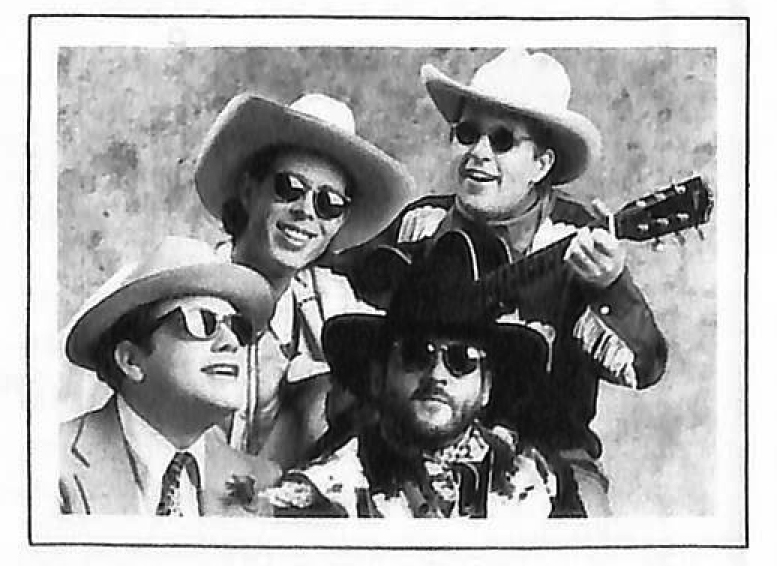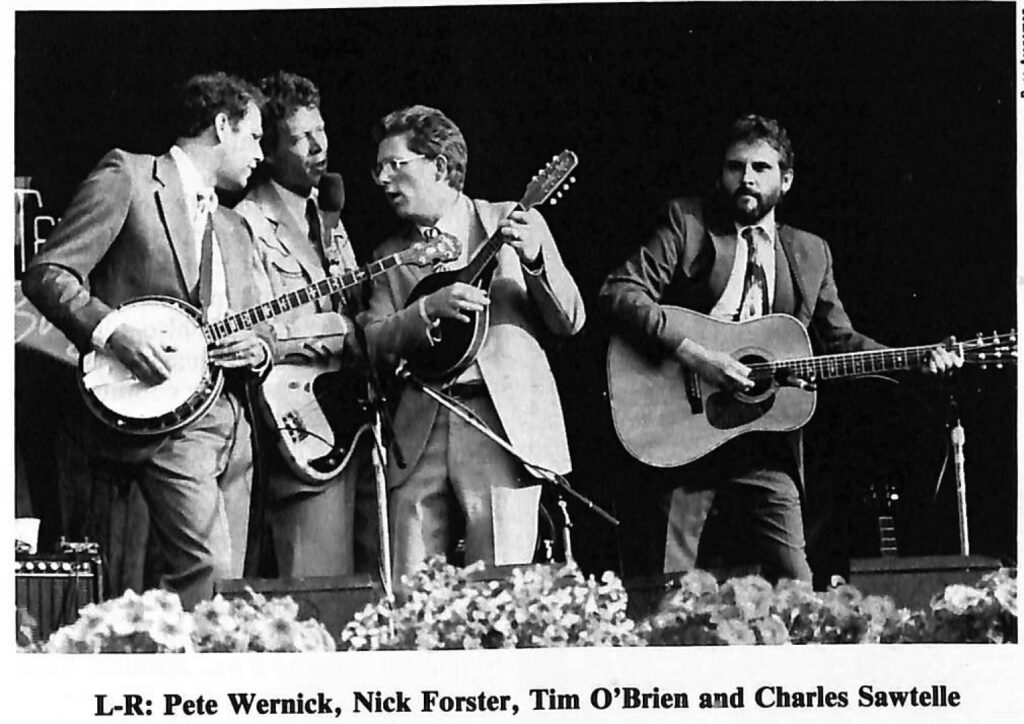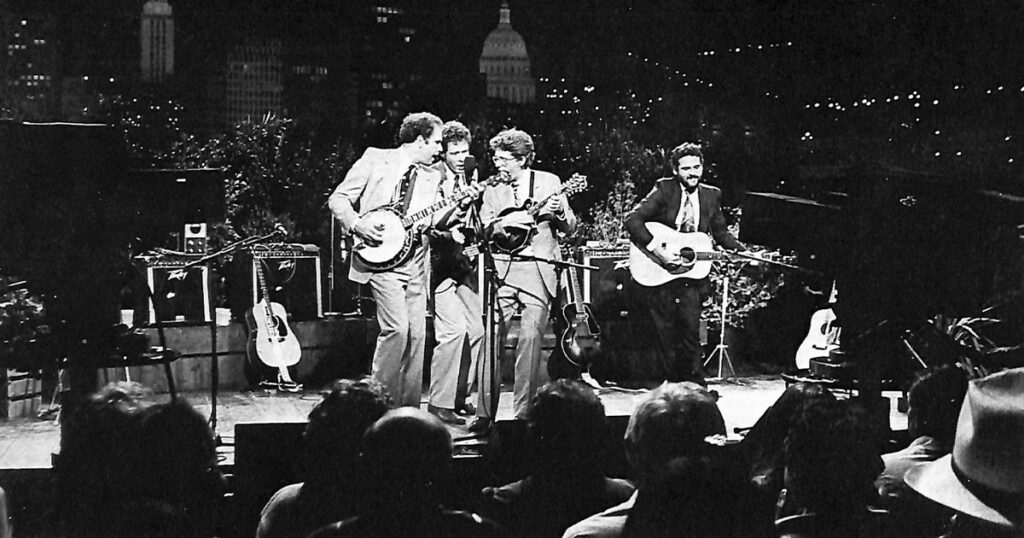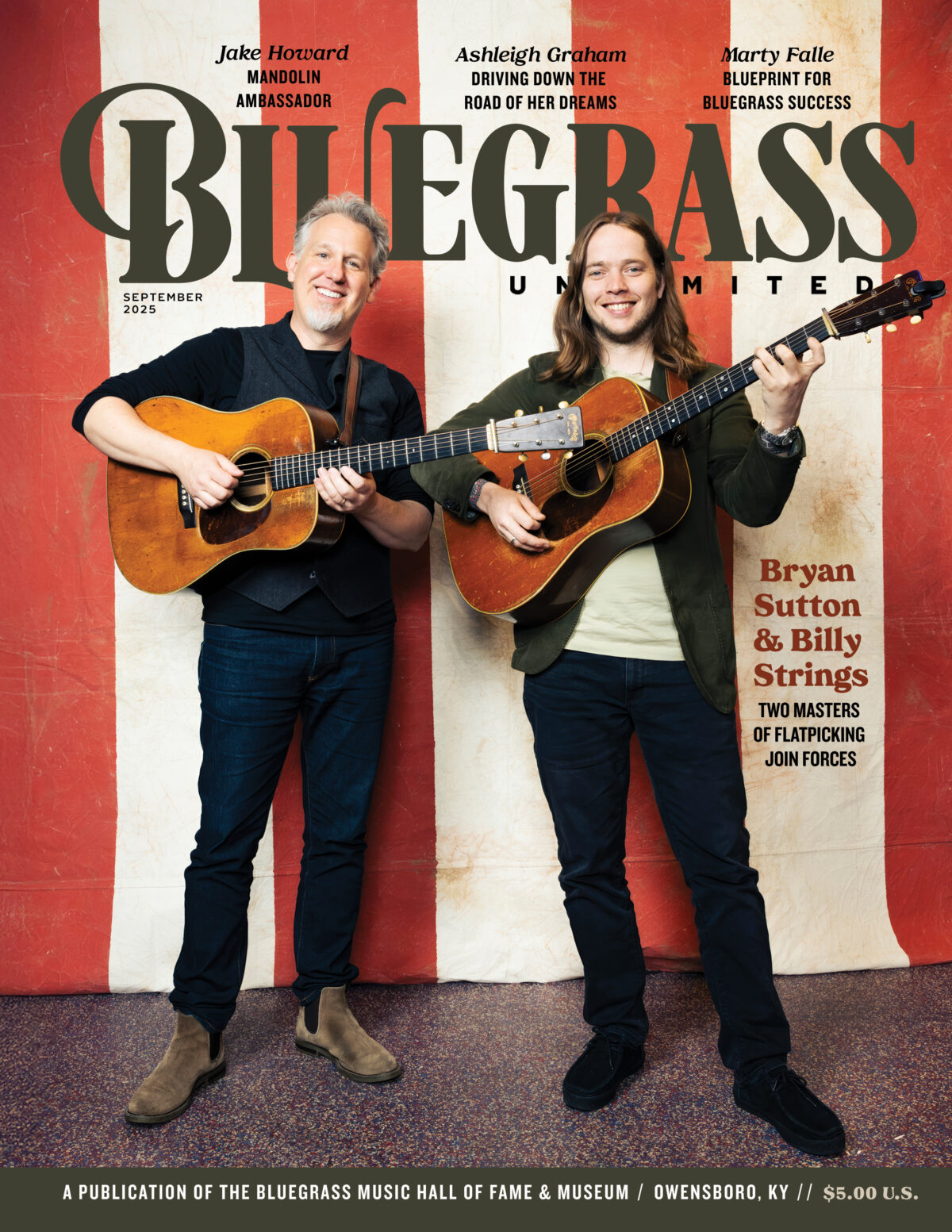Home > Articles > The Archives > Twelve Years: The End of Hot Rize Rocket Ride
Twelve Years: The End of Hot Rize Rocket Ride
Reprinted from Bluegrass Unlimited Magazine
June 1990, Volume 24, Number 12
The Hot Rize boys have just been called back to the stage for their third encore at Liberty Hall in Lawrence, Kansas. Roses are delivered to the stage by four young ladies and the entire packed house, including a group of guys in the balcony dressed in western shirts like Red Knuckles and the Trailblazers, waving fly swatters and holding up their new Slade bumper stickers, are all on their feet, not ready to let this be the last Hot Rize song they will hear live. This is goodbye number twelve, in a series of thirty-five farewell appearances the band will make before breaking up April 30, 1990.
It’s been a rough couple of years for bluegrass fans, with the demise of the Johnson Mountain Boys, New Grass Revival and now Hot Rize, one of the most talented groups of musicians and entertainers the acoustic (and old electric) music world has known.
How did this happen, after twelve good years and just when Wendell Mercantile was color coordinating the Velcro-attached fringe on his custom guitar with his various western shirts? “The breakup was precipitated by my giving notice last July,” says Tim O’Brien, lead singer of Hot Rize. “I just decided that as of May 1, I wanted to have a cut off date to try and devote my full-time to my new thing.”
The new Tim O’Brien Band, already booked for appearances at Telluride in Colorado, the Winterhawk Festival in New York and the Strawberry Festival in California, will also include Nick Forster, Hot Rize bassist, on guitar; Jerry Douglas on Dobro and Mark Schatz on bass.
“It was not really shocking,” banjoist Pete Wernick comments, “because we knew that Tim was going for a record deal and he was making slow, steady steps in that direction. I’ve really enjoyed the band,” Wernick says, “It’s been a real nice thing for me to be part of. To see it go into the past has got to be sad. But in a way, it’s sort of like high school graduation—twelve years. And the future has a lot of possibilities. Sometimes you’re scared and sometimes you’re eager to jump into the future.”
In 1989 RCA was “sniffing heavier and heavier around Tim’s trail,” according to Wernick. Six executives flew out to a Hot Rize gig in the Washington, D.C. area, in a private plane and took a limo to the theatre to see what O’Brien was like in front of an audience. Two months later they were present again for a Tim O’Brien style band showcase in Nashville and two weeks later he got the call from RCA saying, ‘I want you.’ ”
“At that point we knew what that meant,” says Wernick. “It was just a question of when he’d move out of the band.” And after Tim asked Nick to join the new group, the remaining members of Hot Rize decided not to try and go on.
The Tim O’Brien Band will still be acoustic, but “more contemporary,” he explains. “The feels and the grooves are not bluegrass necessarily.” But “the flavor of bluegrass and old-time music and traditional country will certainly be in there, along with a lot of other styles: rhythm and blues, swing and that kind of thing,” Tim says. “I’ve got a lot of original songs that I’ve been writing over the years that we haven’t done, some of which are on this record that’s coming out next fall.”
So the bluegrass fans don’t need to worry about O’Brien selling out, hiring sequined back-up singers and dancers, or the new band dressing like Red Knuckles, or anything. “I never did dress like Red Knuckles,” Tim clarifies. “I’m just going to try to be myself and do what I like to do and just continue with that.”
Along with the new group, Nick Forster has immediate plans to tour eastern Europe in May with Laurie Lewis, Sam Bush and John Cowan, on a U.S. State Department engineered project. Pete Wernick, a.k.a. “Dr. Banjo” and “Mr. President” of the International Bluegrass Music Association, has seven banjo camps lined up for 1990: one in Oregon, one in Pennsylvania in connection with the Gettysburg Bluegrass Festival and the rest near his home in Colorado. These events usually involve around twenty students, four days of intense individual and group instruction and a fair amount of Niwot hospitality and home cooking from Nurse Banjo, Pete’s wife, Nondi.
In addition to the camps and spending time at home with his seven- year-old son, Pete is planning writing projects, a new instructional video for Homespun Tapes and a solo album. He’s also looking forward to doing some gigging with Jody Stecher, a buddy of his from New York and Jody’s wife Kate Brislin, who have a new album out.
“I’m going to do some playing with Tony Trischka,” Pete adds. “We have this idea where the two of us walk out together and play just two banjos for awhile. We have a bunch of different types of playing that we do together privately . . . We’re both eager to see how that might go.”
As for guitarist Charles Sawtelle, introduced on stage by Forster as “the man trapped in a world he did not make,” things are still pretty much up in the air. “I want to get back and play music in some format that I just don’t know yet,” he says. “Maybe electric.” Hot Rize has been working hard this spring and Charles is looking forward to taking a couple of months off before he gets involved with another band. Also, he’s got some recording production work for other groups coming up that he is very interested in doing.
“Old electric music,” (the opposite of new acoustic music), fans will be glad to hear that Red Knuckles and the Trailblazers are staying together and are headed back to Wyoming, Montana. In fact, the locals are having a special reception for Red Knuckles at a spring festival called the Lupine Days. “He’s the King of Lupine Days,” O’Brien says. (A lupine is “a little wildflower that grows in the mountains up there,” Tim explains. And evidentially they “do a lot of whoopin’ at Lupine Days.”)

Red and the Boys have still got their 1950 Mercury and “Red’s wife, Vona has bought them a new 1967 Ford LTD,” O’Brien reports. “They’re going to be traveling in that. They can fit the bass and a couple of amplifiers in and they’ll be all set.”
How did Hot Rize break the news that the older guys would have to vacate the closet in the back of the tour bus? “I wrote it backwards on a piece of paper, I told them to hold it up to a mirror and I left the room really fast,” Wernick admits. “Two hours later they came out and said they felt sorry for us.”
It’s hard to imagine what it must be like to stand up in front of a crowd of devoted fans, night after night, saying goodbye after twelve years of the kind of success Hot Rize has enjoyed. “It’s not unlike what we do all the time,” Nick Forster points out. “We never know when we’ll be back to a place.” But he thinks it’s possible that “the realization of the finality of this tour hasn’t hit him yet.” He says Hot Rize has always tried to create an emotional bond with the crowd and the intensity of their fans’ loyalty is evidence that it has worked. “It makes me feel great,” Forster says, “that they’re interested and connected to us. There’s a lot of love there.”
It’s interesting to try and figure out the phenomenon of the band’s popularity over the years. From a sociologist’s point of view, Dr. Banjo has a few observations. “Everybody makes a contribution,” he notes, “but I’d have to say the biggest single contribution is Tim’s singing. As much as he is a great instrumentalist and we have a lot of other things to offer, I think the lead singer in a band really is the biggest single factor of whether people like it.”
And listeners like the Hot Rize style of bluegrass, “which has a lot to do with traditional bluegrass; but it’s not stuck in the early days, even though there is a constant reference to that,” Wernick says. “We do old, two-chord songs that nobody knows who wrote, they’re so old,” he says. “And then we have songs that are just written that week by somebody in our band or some other contemporary writer.” People seem to like that combination—“to feel that they have roots,” while also looking toward “future sounds.”
Another factor that has made Hot Rize work is the solo work on guitar that Charles does, according to Pete. His influences are not only Doc Watson and Clarence White but also Earl Scruggs, Bill Monroe and Chubby Wise, he says—musicians “you wouldn’t expect to be influential for a guitar style.” A guitar style is one thing Charles Sawtelle has. His unique sense of time, phrasing and dynamics are immediately recognizable to listeners. “Other people have told me that, but I don’t really think of it that way,” Charles adds. “I just sort of play.” “He’s just trying to play like Tony Rice,” O’Brien suggests with a grin.
One fact that does shed some light on where those wild, dark leads come from, is Charles’ training as a visual artist. (He has a degree from Colorado State University in fine arts.) “I like the artists that are the equivalent of the bebop jazz guys,” Sawtelle explains. “I like the abstract expressionists a lot. I think that sort of fits in, somehow. I like non-representational art and I can understand it. So maybe that’s the way my playing is coming out too: non- representational.” (Imagine each note of the next Sawtelle break you hear as a blop of black paint flying at a canvas and see what you think.)
Pete Wernick also points out that Nick Forster’s MC work and offbeat sense of humor has made the band popular with crowds. Nick says he approaches his comments on stage like a guitar solo. He likes to have a beginning and ending in mind, at least, in case he’s not inspired to improvise. He also does a good job of keeping song introductions informative and he likes to reveal strange, interesting things about the personalities in the band. (Charles is “the bluegrass mystery,” Pete “has been to college more than the rest of the band put together,” Tim is an Eagle Scout and Nick himself was born in Beirut, Lebanon and was once bitten on the hand by a weasel.) Improvisation is his goal and Nick does a fair bit of it, sometimes even telling audiences about his latest dreams. But if inspiration doesn’t strike, he says, “it’s better to have something ready, rather than risk just standing around and saying something inappropriate. After all, it’s show biz!”
Also, “as much as I hate to say it,” Wernick continues, “Red Knuckles has helped Hot Rize fly. A lot of people like them more than us and they’re a big part of the show.” It was Tim O’Brien’s idea from the beginning that Hot Rize would not be simply a bluegrass band. “It takes a pretty dyed-in-the-wool person to want to sit and listen to two hours of bluegrass.” Wernick says. “But when you have a little break in the middle and then you get back to it, the bluegrass sounds fresh all over again… It keeps everybody guessing and it keeps us fresh.” At first, Hot Rize tried their hands at the “old electric instruments”: electric guitar, electric table (non-pedal steel guitar), bass and rhythm guitar. But they soon discovered that the same country/western hits from the ’40s and ’50s, with the same dialogue, went over much better when another band came out on stage, dressed in sunglasses and western attire. Red Knuckles, Waldo Otto, Wendell Mercantile and the mysterious Slade were a hit.
“At times, things with Red have been entirely spontaneous,” Nick says. “The things that work, we keep and the things that don’t work, we don’t. Waldo is pretty spontaneous,” he adds. True Trailblazer fans, known as Knuckleheads, pride themselves on Trail-trivia. Remember Waldo’s vintage chocolate discount donuts, Slade’s walking bass and his hobby of tying flies, the Eat Cafe, Waldo’s bid for the Presidency in 1988 and his “metal block” tricks, Red’s tribute to music of the ’60s and the choreography behind “Apache”?
The other ingredient of the Hot Rize magic is something not very magic at all—their practical, day to day attention to detail in all aspects of the business and their efforts to make consistently high quality records. “Whether it’s the way we look on stage, or the way our harmonies are coming across—sounding through one microphone, or how we arrange our songs, or how we arrange our set,” Wernick says, “we discuss all these things. And we also vote out things. We care about details that I think a lot of people let slide by. It’s very time- consuming and it’s not much fun to hammer out these policies about different things. But when all is said and done, I think a lot is gained by the process.”
Frank Edmonson, road manager and sound man for the past nine years, is in charge of maintaining the perfection of the Hot Rize sound. For a long time, he says, Hot Rize was the only band that had a road manager and resident sound man, besides New Grass Revival. “People started asking why Hot Rize always sounded better than other bands,” he recalls. The reason, of course, is Frank and his work with other sound engineers where the band plays. Edmonson feels that overall, a lot of people are developing more of an expertise in the field of bluegrass sound. Some just give up because it is so much more difficult to engineer a true acoustic sound than to just switch over and work with electric instruments. But Frank says, “It’s worth it, for the joy of having a good show and listening to the tone of the instruments.”
In addition to live performances, consistently superior albums have attracted new fans and attention from promoters. “The first time we were asked to go to Europe, it was just because the promoter there had heard our first record,” Wernick points out. “He invited us just on the strength of that.”
Credit also goes to Keith Case, the agent who has kept Hot Rize working since 1981. (Pete did the booking chores for the first four years.) Experience adds polish. “Any group that is fortunate enough to stay together for a long time will reach a certain level of maturity as a unit,” Pete says, “that you just can’t get the first year.”
At the foundation of the polished Hot Rize sound is Nick Forster’s bass, unobtrusive and authoritative at the same time, driving the band along and fitting in perfectly. Traditional bluegrass fans have been very complimentary of his style and volume, overall. His playing has probably helped increase the tolerance for and appreciation of an electric instrument used in a bluegrass context out on the festival circuit; although he remembers a festival in Oklahoma eleven years ago when he was booed and hissed when he walked on stage with the electric bass. (Actually, Nick didn’t choose the electric over the acoustic bass. “That’s what the band had,” he says. “The job came with an amp and a bass.”

Pete Wernick’s banjo is precise, always tasteful and as crisp as a watercress salad fresh from a mountain stream. Although he also enjoys listening to other types of music, it is Earl Scruggs who has changed his life, he says. “For me to end up as a professional musician, coming from a family where music is not emphasized, it had to do with one thing: Earl Scruggs. I can still listen to his records and get all the goosebumps and inspiration that I’ve ever gotten, because he’s just a master musician and really unique,” he continues. “It’s nice to be in a band where I get to play in that style and try to emulate the sounds that he made.”
At center stage of the Hot Rize Show is Tim O’Brien, with soaring, bluesy vocals backed up by soulful mandolin and fiddle that he makes look so easy. O’Brien appears to be relaxed to the point of unconsciousness at times; but he says, “No, I’m working real hard at it. I spend a lot of time working stuff out and just being in shape.” It’s interesting to find out that Tim didn’t even own a mandolin two years before Hot Rize. “Before we started this band, I concentrated more on playing the fiddle than about anything else,” he recalls. “And I wasn’t a lead singer in any band I was in. It’s gotten to be a thing where the vocal became the most important of my various duties as a musician. It meant that the mandolin was a lot easier to play than the fiddle while you’re singing. And I fell in love with the mandolin too, over a short period of time,” he says, “because of the rhythm aspect of it.”
From Dr. Wernick’s observations, the blend of personalities and geographically diverse backgrounds is as interesting as the combination of their instruments. Nick Forster comes from a family with very upper class origins: John Jacob Astor, of the fur trading business from the 1800s, is one of the better-known of his ancestors. “He’s practically the first male in his family, in 200 years, to choose not to go to Harvard,” Wernick notes; “and he went to prep schools in Vermont and Switzerland.” Charles Sawtelle, on the other hand, was born in Austin, Texas, and has lived in Canada and Colorado. “He dresses western, he thinks western, he acts western and he is western,” Pete says.
Tim O’Brien is from Wheeling, West Virginia, and his father is a lawyer. “But he also would hang out with the tobacco-chewing bluegrass guys from over the river in Ohio,” Pete says. People with a wide range of musical tastes can enjoy Tim’s singing, Pete believes, because of the combination of elements from his background that come out. “Tim’s family listens to Bing Crosby, but Tim also listens to Bill Monroe. So his singing’s right on the line between the mellow and the real hard, bluesy sound of bluegrass,” He also went to military school, so he’s “not a real show boat and he keeps to himself a lot,” Wernick says, as a result of training that developed restraint and discipline.
Pete Wernick got a doctorate in sociology at Ivy League, Colombia College; and he’s from “New York City, where people are pretty willing to be verbal and analytical,” he says. Frank Edmonson, like Sawtelle, is also “predominantly western in background and outlook,” Pete says. So the combination of the creativity of the five, the “resonances and frictions” that have to do with their “common and uncommon points,” is a part of what makes them interesting to each other, as well as to the public, Wernick says.
Looking back, Hot Rize has achieved many things they never dreamed they would have the chance to do at the beginning, when they were just looking to make it through the first year. They have toured Japan, Australia and Europe and they have appeared on national television, as well as the hit radio series, “A Prairie Home Companion” with Garrison Keillor.
Each year things got better. “We turned from a bunch of unknowns into a band that was making an impression on people,” Wernick says. “And it got to where we were invited to most of our favorite festivals year after year. I think if you asked any bluegrass musician what their dreams might be when they got involved, it would have to be those things. And we got to do them for not just at little bit of time, but for quite a while. So that’s been neat.”
Wernick loves bluegrass festivals—“everything from hearing the other bands to jamming late in parking lots and just hanging out with the people and being in a beautiful environment,” he says. He also admits to being somewhat of a “hero worshiper as a young bluegrass guy coming up.” So it’s been a real reward of the occupation for him to meet backstage and interact with some of his favorite bluegrass musicians like the Seldom Scene, J.D. Crowe, Doyle Lawson and the New Grass Revival. “I can’t say I’m a buddy of Bill Monroe’s, but just to be around him more than I would have been otherwise has certainly been educational and interesting,” he says.
As for the future, Hot Rize has already been getting financially tempting offers for reunion concerts, before they have even broken up. They’re not ruling out that possibility in the distant future, “but there’s an obvious situation going on,” Wernick explains. “Tim is launching his rocketship and when you’re in the middle of launching a rocketship, you don’t go back and look over the one you’ve been riding on for awhile. And on some level, it’s good to just put Hot Rize to rest for a while, to say, ‘That’s over with,’ and to look around and see what else is going on.”
Whatever direction these five talented individuals head off into, it’s certain that bluegrass fans worldwide will be watching with interest. It’s been a nice rocket ride the past twelve years, guys. Thanks.

